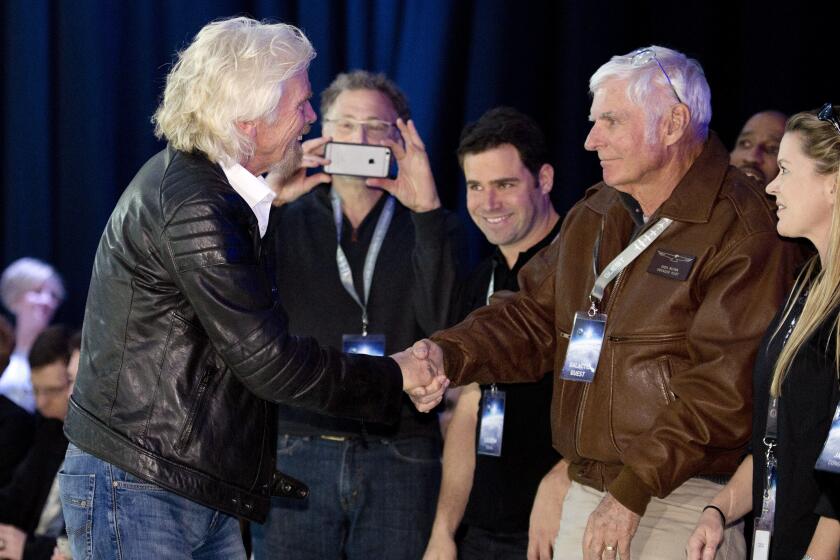Board Games Are Hot for the Holidays Again
Today’s board games have gone far beyond Parcheesi, Chinese checkers and other dusty parlor pursuits.
Now there’s Cranium. The Six Degrees of Kevin Bacon Game. Malarky. Zobmondo. And variations of Monopoly, from the NHL Collectors Edition to the Scooby Doo! Fright Fest Edition.
Board games are hot for the holidays for a number of reasons.
“For years, people would run off to their television sets to play video games, solo. And there’s nothing wrong with that; those things still sell,” said Richard C. Levy, who has been creating board games for 20 years. “Now, as Americans get older and want to spend more time with successor generations, with family, they’re playing many more games.”
And with the economic slowdown, it also makes sense, Levy said. “A lot of games, including Monopoly and Scrabble, came out of the Great Depression. It’s a very inexpensive way to entertain.”
Colleen McMillen of the Toy Industry Assn. said board games have enjoyed a resurgence in the past few years. Interest increased even more after Sept. 11 because people were staying closer to home with family and friends.
Trivial Pursuit, introduced in 1979, started the adult board game boom, Levy said. But games got a boost in 1998, when Hasbro Games began its “Family Game Night” advertising campaign.
Hasbro, which owns a huge chunk of the board game market, encouraged families to set aside a night to play games instead of settling in front of the tube.
“I believe it had a tremendous impact on the entire industry,” said Levy, who also is the author of “The Complete Idiot’s Guide to Cashing In on Your Inventions.”
Because the holiday gift-buying season has a long way to go, it’s difficult to say which games are best sellers this year. Monopoly, Scrabble and Clue, which are produced in myriad editions, are evergreens, selling more than 1 million copies a year, Levy said.
According to AreYouGame .com, an Internet site that bills itself as the largest game and puzzle store on the planet, the following board games are doing well this year:
Electronic Catch Phrase (described as “Password meets Hot Potato”); True Colors (in which players find out what others really think about them); Monopoly: The Simpsons Edition; In Pursuit (a combination of Trivial Pursuit and reality-TV survivor games); Spinner Dominoes; the Worst-Case Scenario Survival Game (based on the best-selling book series); Battle of the Sexes; the “Green Eggs and Ham” Game; Dr. Seuss Trivia Game; Nemesis Factor (a light-up game that challenges players to decipher patterns); Cranium Cadoo (a knockoff of the popular Cranium game for kids); and games based on the Harry Potter books.
Whether this season’s top sellers will be on shelves next December is hard to say. The game business is very competitive, said Richard Tait, the Scottish co-creator of Cranium.
The popular game billed as “the game for your whole brain” has players sculpting objects in clay, spelling words backward, whistling popular tunes and other zany tasks.
Game experts and inventors say a successful game has to have certain key elements.
Levy mentions what the game industry calls “the 2-minute rule”: that players should be able to open the box, start playing and have fun within a couple of minutes.
Another thing: Keep it fairly easy, Levy said.
“People who design games shouldn’t try to make them so hard that it’s not fun. What you want to do in a game is have everybody feel that they have the answer on the tip of their tongue. But guess what? When the sand is falling through the hourglass, in the pressure of the moment, they’ll blow it. That’s the key.”
These days, something called “brand equity” is important. Levy, who created the “Men Are From Mars, Women Are From Venus” and “Chicken Soup for the Soul” games, said games aren’t typically promoted on television these days. With the number of games in stores, having a recognizable name--such as one based on a best-selling book--boosts appeal to retail outlets that sell the games and to people who buy them.
David Parlett, who has written books about games and created some as well, including Hare and Tortoise, said his ideal family game is for two to six players, with four being optimal; that skill and strategy dominate over chance and luck; and that it should last 30 to 60 minutes.
“The theme or story line should be strong and amusing enough to allow scope for artistic design, but not so strong as to artificially force the abstract gaming elements into a straitjacket of conformity with so-called real life situations,” Parlett said. “A topical theme soon becomes untopical and then wears off.”
Levy also said games need to “have a touch of abracadabra, some magic.”
In his latest game, Spirit of America, a tie is broken by the player who sings the best rendition of a patriotic song.
Erik Arneson, a game enthusiast who manages www.boardgames.about.com, said the instructions have to be clear, too.
“For something to have very broad appeal, it has to be understandable quickly. And I think that’s what’s really key, is that rules have to be written well. Rule-writing is an underappreciated art.
“I own probably 200 games and have seen the rules for many more than that, and some of them are dreadful.... It’s not an easy thing to do.”
*
Feeney is a reporter for the Hartford Courant, a Tribune company.






